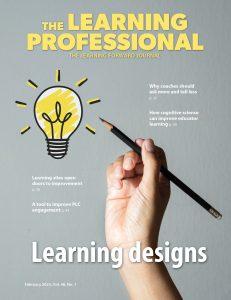Time after time, conversations with decision makers in successful organizations reveal the high value they place on the relationships they try to build among people. The focus on relationships is not to be taken lightly. Toxic relationships diminish capacity (Lewin and Regine, The Soul at Work, 1999). With multiple, increasingly complex initiatives, leaders in successful organizations generate their best work and results from the interactions they have with the people who work there. To create new solutions for challenging problems, they have to have these relationships to enlist the ability and creativity of the people in their schools.
With so much emphasis on massive district and school initiatives, and the burden and urgency we feel as leaders, it may very well be that we accidentally sacrifice relationships and neglect the need to grow the individuals who must enact the changes. We may have succumbed to the crushing weight of these large initiatives and comforted ourselves with the feeling that as long as we are busy “leading,” we must be doing important things. Unfortunately, this “doing things” philosophy often focuses us on managing tidbits of the initiative, causing us to lose the central focus of our work and forgetting that real change depends on individuals to lead those changes. Therefore, during the course of daily leadership, if we lose our focus and let the pressure take us over, we may be making two serious mistakes that actually “de-motivate” people (Patterson, et al, Crucial Conversations, 2011). See if you make either or both of these on a regular basis:
Rely on your charisma to lead the change: Often, we feel that we have such a good relationship with people that they will be drawn into the change because of who we are and our perception that they implicitly trust us. What we find is that compelling people through our leadership charisma simply causes more of a short-term change rather than lasting, intrinsic motivation. In other words, people are behind the change because of the leader’s personal characteristics. This story is repeated over and over. When the leader leaves, the changes fall apart.
Use power to force the change: Frequently, we compel teachers to change and reinforce our power through the identification of their weaknesses. To make it worse, to follow up or to show our “support” for their change, we often match that ineffective teacher with a strong teacher in hopes that the matchmaking will “rub off” on the ineffective teacher. Whether or not this is a soft suggestion or a hard command, it is perceived by that ineffective teacher as a show of our position power, which diminishes that person instead of building on his or her strengths. Time and time again, the teacher views this approach as negative and it results in short-term changes.
My experience is that people are more motivated to make changes when the motivation comes from within. As we have learned from Daniel Pink’s book, Drive (2011), people stay with the change and deepen the impact of the change when they form constructive, relationship-rich collaborations with other change agents and experience some kind of autonomy, recognize a purpose to their work, and believe they can develop their skills to a masterful level.
How do we, as leaders, then, accomplish this? Leaders accomplish this through a shift in mindset; working with people instead of on them, giving individuals choices about their own growth within a range of acceptability; focusing on what hasimproved rather than what hasn’t.
As leaders, we can have it all—rich relationships and a laser-like focus on results. This realization for me has come after many years of making mistakes with people and only focusing on results. Think about these two de-motivating actions and how they, on a regular basis, might be undermining your efforts. How would you reflect on your actions? What would you want to change in your own behavior?
For more about leading change in teacher professional learning, be sure to check out my summer institute, Cultivating Differentiated Instruction: Growing the Teachers Who Grow the Kids.








